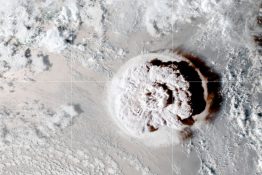Research from the University of Washington shows that signals from the upper atmosphere could improve tsunami forecasting and, someday, help track ash plumes and other impacts after a volcanic eruption. A new study analyzed the Hunga Tonga-Hunga Ha’apai eruption in the South Pacific earlier this year. The Jan. 15, 2022, volcanic eruption was the largest to be recorded by modern equipment.
Read more at UW News »Strongest Arctic cyclone on record led to surprising loss of sea ice
A warming climate is causing a decline in sea ice in the Arctic Ocean, where loss of sea ice has important ecological, economic and climate impacts. On top of this long-term shift due to climate change are weather events that affect the sea ice from week to week. The strongest Arctic cyclone ever observed poleward of 70 degrees north latitude struck in January 2022 northeast of Greenland.
Read more at UW News »UW expert on tropical storms discusses Hurricane Ian
Shuyi Chen, a UW professor of atmospheric sciences, was traveling to a conference in Boston as Hurricane Ian approached the Gulf of Mexico. During breaks at the conference, she provided her thoughts on the closely watched catastrophic storm system that made landfall in Florida on Sept. 28. Q: What are your thoughts on Hurricane Ian? How does it compare to other storms?
Read more at UW News »Study suggests La Niña winters could keep on coming
Forecasters are predicting a “three-peat La Niña” this year. This will be the third winter in a row that the Pacific Ocean has been in a La Niña cycle, something that’s happened only twice before in records going back to 1950. New research led by the University of Washington offers a possible explanation. The study, recently published in Geophysical Research Letters, suggests that climate change is, in the short term, favoring La Niñas.
Read more at UW News »Heat-related mortality risk is widespread across Washington state, study shows
Heat-related deaths are an issue across Washington state, and they occur even in regions that typically have milder climates, according to a University of Washington study published Aug. 30 in the journal Atmosphere. This is the most extensive study yet of heat-related mortality in Washington state, and the first to look beyond the major population centers to include rural areas. Statewide, the odds of dying were on average 8% higher in recent decades on days when the combination of temperature and humidity, known as the humidex, was in the top 1% of recorded values at that location, compared to a day with a mid-range value for humidex.
Read more at UW News »





